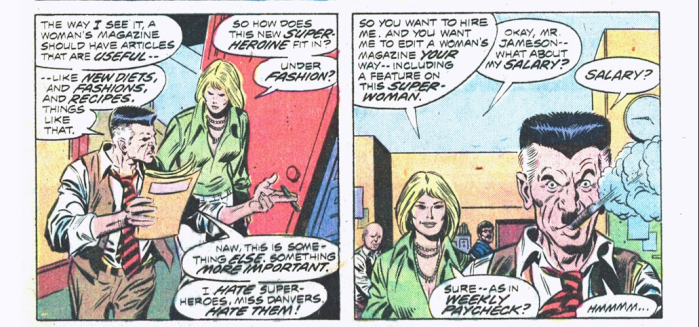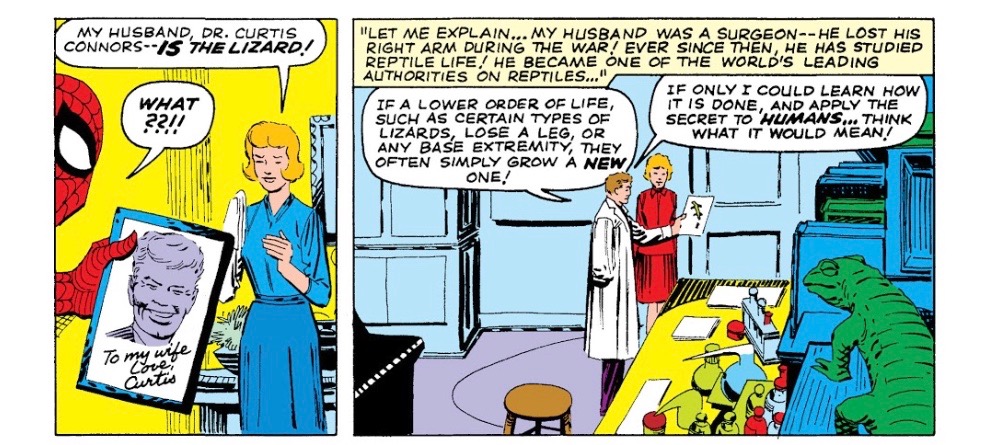It’s widely guessed, especially through various clues appearing in the 1977 Ms. Marvel comic that Gloria Steinem, the founder and editor of the similarly named Ms. magazine, is an important real world inspiration for Carol Danvers or the female Captain Marvel developed in that comic. It’s actually very obviously the case.
The first issue of Ms. Marvel features the J.J Jameson of Spider-man fame hiring Carol Danvers as an editor for a New York magazine called “Woman.” Jameson is interested in developing his woman’s magazine, particularly in light of the appearance of a new mysterious female superhero the audience will come to know as “Ms. Marvel.” The famous feminist Kate Millet is even given a mention by the complaining, “sexist” Jameson. Jameson, while hating the idea of a political magazine for women, does find this new female superhero an intriguing new target. Jameson famously hates super-heroes, especially Spider-man.
Danvers needs a job. The negotiation goes Danvers’ way, she rolls over the oily Jameson, gets her salary and crushes one of Jameson’s foolish expectations. To wit, she won’t be publishing articles about “diets and recipes.” [1]Danvers receives her superhero name in that issue as well. Daily Bugle City Editor Joe Roberston asks her name while she is in her superhero form. Sputtering she realizes she doesn’t have one. So he addresses her simply as “miss.” As in, of course, Ms. magazine. Graphically, the magazine founded by Steinem itself went under the simple title of “Ms.” Like Steinem Carol Danvers will even sport the middle part hairstyle popular in the day.

With Marvel characters like Black Panther, we are, of course, unsurprised that a liberal or even radical activist would be referenced in their comics. True, Stan Lee, employing a common “Exoteric Alibi,” claimed that Black Panther was not a reference to the Black Panther Party. His proof was that the Black Panther comic book character, appearing in July 1966, had appeared earlier than the Black Panther Party founded in October 1966. But this is wholly disingenuous.
The famous Oakland-based Black Panther Party took its name from the Alabama-based Lowndes County Freedom Organization, a black civil rights group which also referred to itself as the Black Panthers. Stokely Carmichael founded his group in in 1965.
In any case, as it concerns Carol Danvers as a feminist figure, the ethnic or Religious dimension is more interesting to us. After all, there we find actual “root cause,” and not merely otherwise unorganized women enacting the desires of an empowered, male elite, nascent or otherwise.
Gloria Steinem is a Jewess, descending of a Jewish father, and, more importantly, Jews have played a central role in the deleterious second-wave feminist movement. As my broader study points out, even mythological proto-Jews, such as Vulcan, are shown in the role of “Male Feminist” or as promoters of “feminism.”
For instance, Vulcan suffers his expulsion from Olympus, in one version of the tale, because he intervenes in an argument between Jupiter and Juno, ostensibly on Juno’s behalf. He’s also the liberator of the proto-feminist figure of Minerva, “Goddess of Wisdom,” releasing her from the Aryan Jupiter’s head with a lobotomizing blow from his axe or hammer.
It is true Gentile writer Roy Thomas is credited with creating the character of Carol Danvers, along with Jewish artist Gene Colan. However this detail, taken on its own, is highly deceptive. Firstly the newly arrived writer Roy Thomas (27 at the time) had been at Marvel only two years. He was still then under the tutelage of his hirer, Stan Lee, who had been and would be the main writer and art director at Marvel through the 60s.

Secondly Carol Danvers first appears in a Captain Marvel series that had been developed and planed by Stan Lee. Stan Lee, along with Gene Colan, are credited with creating the original plotline and premise of that series along with all the primary characters including Mar Vell, Yon Rogg and Una.
Stan Lee, along with Jack Kirby, also created the Alien Kree/Skrull universe from which the aforementioned characters appear. Lee would also serve as the editor on the 1968 Captain Marvel reboot from its 1967 origin in Marvel Super-Heroes #12 until August 1970. Lee wrote the first issue of the series appearing in Marvel Super-Heroes #12. Roy Thomas wrote the subsequent issue where Carol Danvers first appears.
Thomas then wrote the first four issues of 1968 Captain Marvel series, where the series, beginning under the Marvel Super-Heroes rubric, was continued under its own name. Thereafter Thomas shared writing duties with various writers under Stan Lee’s editorship. In short, Carol Danvers, along with the universe she inhabits, is a thoroughly Jewish invention.
Here we should note that the character Carol Danvers appeared at least a year before Gloria Steinem emerged into the public consciousness as a feminist activist with her famous 1969 article entitled “After Black Power, Women’s Liberation.” She also appeared well before Gloria Steinem would become the editor of Ms. Magazine in 1971. Hence whereas we can reasonably assume Black Panther was inspired by, at least in large part, an extant group called the Black Panthers, it is not the case that Gloria Steinem influenced the creation of the original Carol Danvers.
Indeed, Carol Danvers first appears in Marvel Super-Heroes #13 as the worshipful love interest of the male Captain Marvel, Mar Vell. Here she is without the superhero powers she will acquire in the Ms. Marvel comic.
Nevertheless, Carol Danvers was primed for her eventual role as Ms. Marvel. After all, from the beginning, she shows “feminist tendencies” with these early parables commonly depicting a “battle of the sexes,” particularly between Carol Danvers and Walter Lawson, Mar Vell’s secret identity. Remarkably as well, like Gloria Steinem, Carol Danvers is a Jewess.

Carol Danvers the Jewish Lesbian
With Carol Danvers creators appear to cleave to the naming conventions of JEM. Again non-Jew Roy Thomas was the writer when Danvers was introduced. Thus he is commonly credited with her creation. Yet here we should understand that the origination of this or that name is also subject to the influence of conscious Jewish Esotericists, who may give, “float,” suggest, endorse or encourage meaningful name options or, as in this case, approve them.
Indeed, that the first name Carol is solely Thomas’ inspiration is highly unlikely even when we remove the possibility of esoteric messaging. After all it seems clear that creators drew inspiration from a strikingly similar comic book character appearing elsewhere in the tiny and incestuous universe of New York comic book publishing. This comic book character is Carol Ferris appearing in John Broome’s 1959 reboot of DC’s Green Lantern. Carol Ferris, daughter of Karl Ferris, likewise plays an “empowered,” combative female vis-à-vis Green Lantern’s alter ego, Hal Jordan.

Indeed, Carol Ferris and Carol Danvers have strikingly similar roles. Whereas Carol Ferris is an Executive at the Ferris Aircraft Company, Danvers begins as a head of Security at a NASA rocket base. Carol Ferris and Carol Danvers are also engaged, at least initially, in nearly identical relationships. Both are in love with Green clad superheroes who owe their powers to extraterrestrial sources. Both Green clad superheroes are in alliance with blue-clad or blue skinned men obedient to a mysterious ancient intelligence well beyond their powers or comprehension.
Both Carol Ferris and Carol Danvers are frequently at odds with the non-superhero human identities of these superheroes. Both tales, in contrast to other comic book parables, very notably treat the theme of “empowered women in the workforce” and the “battle of the sexes.” Indeed, to exaggerate this “battle of the sexes,”
Carol Ferris will eventually become the super villain “Star Sapphire from the Seventh dimension,” a persona Jewish writer Robert Kanigher invented in 1947. The Seven here, as in the Biblical works, is a reference to the proto-Jewish God Saturn as this study discusses. The word Sapphire means “dear to Saturn” according to etymologists. These are all things the Jewish writer of the Silver Age Green Lantern series, John Broome, and then later, Stan Lee, would have recognized.

Indeed, the Carol appearing in Broome’s Green Lantern, like Carol Danvers, is also intended, esoterically, as a Jewess. The first name Carol, a feminine form of the male name Karl, is a Jewish identifier and an example of the Frankish motif covered in this study. Ferris, meaning stone, is also a Jewish identifier. Hence both her and her father, Carl, are indicated as Jews.
With Carol Danvers the surname Danvers also confirms Jewishness. On one level is a reference to the character and tribe of Dan appearing in the Hebrew Bible. Dan is a Jewish or proto-Jewish figure particularly identified with the Semitic figure of the snake or viper through Jacob’s Blessing in Genesis. Indeed, it is in my view, highly unlikely that Stan Lee would approve the assignment of such a name to a non-Jewish character.
To be certain, a Jewish intelligence seems behind this very interesting name of Danvers. After all, it is a name that, aside from being a simple Jewish identifier, appears to carry great significance in conformance with other names appearing in this parable.
The name Danvers is a French habitational name for someone from Antwerp or as the French say someone from “Anvers.” Why this reference to Antwerp? In my mind there are two possible explanations and both are related to suspected etymologies of Antwerp. One salient etymology posits the name Antwerp arises from a local myth regarding a giant who cut off the hands of boatmen who refused to pay his toll, throwing their hands into the river. Eventually a hero cuts off the giant’s own hand and throws it also into the river. Hence the werp comes from the Dutch werpen meaning to throw, with Antwerp meaning something like “hand throw.”
If this is at least one intended meaning of the name, Danvers, Jewish creators are making a reference to the Hamsa or what we might also call here the “Tyr motif.” Stan Lee makes this reference in at least two other places with the one handed Aryan figures of Ulysses Klaw, an opponent of Black Panther, and Kurt Connors or the Lizard, an opponent of Spider-man. This Hamsa motif is ultimately a reference to racial cuckoldry and the castration or disempowerment of sexual competitors. To be certain this theme of racial cuckoldry will figure saliently in these early tales featuring Mar Vell and Carol Danvers.

A second possibility, which would be supported by scenes appearing in the 2019 Stan Lee produced movie Captain Marvel, is that the word is a reference to lesbianism. Indeed, many Dutch etymologist argue Antwerp means “at the wharf” or “at the warp.” A “warp” (thrown ground) is a man-made hill or river deposit beyond which lies protected dry ground. As a man-made phenomenon, it’s a synonym for dyke. Here it’s important to remember that in JEM elemental identifiers appear in names as well.
Hence whereas an aqueous reference may indicate an Aryan figure, especially a malleable or sexually available one, one suggesting earth, dryness or the interruption of water may suggest otherwise. Carol Danvers will be known as “in charge of security of The Cape” (as in Cape Canaveral) in the 1968 Captain Marvel series. This may tend to support the theory that her name is a reference to dyke. Here it becomes clear that “Cape” in this title also has phallic significance as this study will discuss. Hence, as a “dyke,” she is securing the “Cape” from “water.”
On the other hand, while the combative, “feminist” career woman Carol Danvers is perhaps only metaphorically a “dyke” in her early appearances, it does seem that 2019 film did move Carol Danvers in a more explicitly lesbian direction. After all, in that film the original Carol Danvers love interest, Mar Vell, is replaced by a woman. Indeed, instead of going by the “human name” Walter Lawson, she goes by the name Wendy Lawson. To be clear, though, Wendy Lawson is not explicitly indicated as a love interest in this film.
Regardless, the lack of a male love interest, a strong feminist subtext and the appearance of a close African American female friend named Maria Rambeau, strongly suggests the 2019 version of Carol Danvers as a lesbian. For instance, in the film it is indicated that Carol Danvers is roommates with fellow military fighter pilot Maria Rambeau while living off-base.

Here it is strongly suggested, as well, that Carol Danvers played at least a tangential role in raising Maria’s daughter. It is clear as well that the filmmakers intended to build an emotionalized, flirty relationship between the pair. There is another consideration. While Maria Rambeau appeared first from Roger Stern’s pen as the mother of a new African American Captain Marvel, Monica Rambeau, the use of this character in the 2019 film, because of her name, is interesting.
The name Rambeau is thought to possibly derive from the Germanic personal name Hrambehrt or Hrambald meaning “bright crow” or “bold crow.” The crow as this study indicates is a symbol of racial cuckoldry against the Aryan Apollo. Hence this may as well suggest Carol and Maria as a couple.
Further suggestive evidence appears. The 2019 film begins with the premise that Carol Danvers, formerly a human, has been inducted into the Alien race of the Kree with no memory of her former human life. There she goes by the name Vers. The name is derived from her old shattered military name tag from when she served in the air force as a fighter pilot. During a plane crash, the “Carol Dan” was split from “Vers.” Danvers retained the portion of the tag containing the word “vers” so Vers become her name.
Vers is a known term in the homosexual community indicating a homosexual who is neither “top” nor “bottom” but “versatile.” While it is unclear precisely when this colloquial shortening of the word versatile developed, the “sexual identity” it describes has been in the public consciousness at least since 1979 when it was discussed in The Gay Report, a famous statistical and sociological study of 5000 homosexuals.[2] Certainly the slang term “vers” was well established prior to the development of the 2019 film.
Certainly as well this film can be considered homosexual propaganda. Here we see, as with all JEM, messages are introduced subtlety, esoterically, through the careful use of symbols, especially in more “mainstream” works. This begins the process of demoralization and degeneration. It prepares the way for more explicit works and establishes the Caducean, creating false “wholesome” alternatives from explicitly degenerate propaganda.
Nevertheless, when Carol finds the other half of the name tag, as she is recovering her memory, it does seem suggested as well that she is recovering a Jewish identity, remembering she’s “of the tribe of Dan.” After all, shortly after this point Danvers will begin to rebel against the Kree who are esoterically indicated as Christians as this study will show. She will do this by joining in an alliance with the Skrulls, who are esoterically indicated as Jews. The word ver, related to vernal, means “springtime” and perhaps, if less likely, this meaning was considered as well. In other words Carol Danvers is experiencing a “Jewish Spring” or Jewish awakening.

To be clear, one reading does not exclude the other. Indeed, Jewish parables are frequently “layered.” This is particularly true in Old Testament works where Hebrew adds another world of meaning entirely.
Likewise, a lesbian reconnecting to Jewish roots is wholly within our known understanding of Judaism. In other words, such occasional “loses” become permissible so far as a final allegiance is given to the security and dominance of Judaism. We remember as well that Judaism is a Bride Gathering Cult so the heterosexuality of Jewesses is not the top priority. Hence, rather than a mere lesbian or a “Vers,” Danvers becomes once more “whole,” a Jewess loyal to the larger aims of Jewry.
As a final note on Carol Danvers Jewishness, it’s perhaps worth noting as well that Marvel gives Carol Danvers the middle name of Jane. Jane, a form of John, as in John The Baptist, is likewise a common Jewish identifier appearing in JEM. Lee features it in multiple characters. Spider-man’s love interest, Mary Jane, the WASP-presenting Wasp character, Janet Van Dyne and Thor’s love interest, Jane Foster. All are indicated esoterically as Jewesses.
Find Captain Marvel Part II here: Captain Marvel Part II: The Christian Kree and The Jewish Skrulls
[1] Gerry Conway, Ms. Marvel, Marvel Comics, January 1977, Pg. 7
[2] Jay, Karla; Young, Allen (1979). The gay report: Lesbians and gay men speak out about sexual experiences and lifestyles. New York: Summit
3 thoughts on “Captain Marvel Part I: The Jewish Feminist Carol Danvers a.k.a Ms. Marvel”